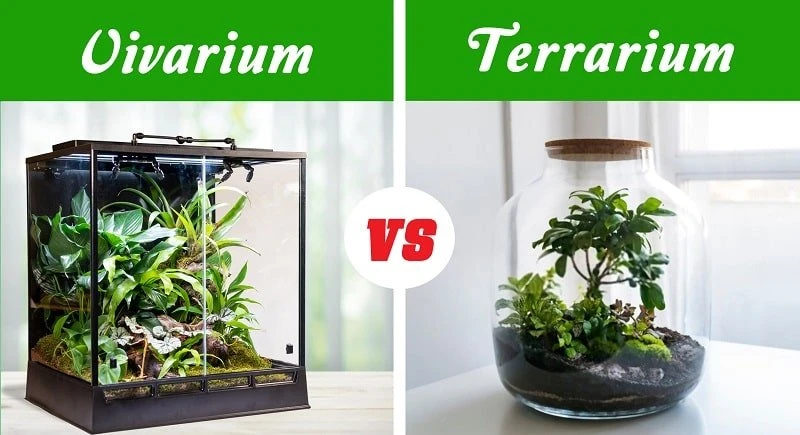reviewed by Christina Lopez
The terms vivarium and terrarium may seem strange if you are unfamiliar with the upkeep animals, such as reptiles. However, many people find it challenging to differentiate between the two terms. Additionally, the two words are often used interchangeably, making it hard to distinguish between them. If you are in such a scenario, don’t worry; we will help you figure out the difference. Read Vivarium Vs Terrarium to know more!
Contents
A terrarium is a hybrid tank that is used to house aquatic and land animals. Terrariums are made to resemble plants’ natural environment. A terrarium is a little garden in a transparent container where plants, soil, air, and water combine to coexist.
The term vivarium originates from the Latin word “Vivere,” which means to live. Therefore, a vivarium can define as anything used to make a pet’s home. Moreover, the word vivarium refers to any reptile tank made of glass, plastic, or wood. To put it simply, anything, where your reptile can live is a vivarium. If that is the case, a terrarium is a form of a vivarium.
Note that when animals add to a terrarium, the container turns into a vivarium.

A terrarium is a container that houses plants, while a vivarium is a tank that houses animals.
To help you understand a terrarium and a vivarium, we have developed quick comparison charts hereunder.
Quick comparison chart for Vivarium Vs Terrarium
Here is a quick comparison chart(Vivarium Vs Terrarium) showing the inhabitants of the terrarium and vivarium.
| Vivarium | Terrarium | |
| Water | Sometimes there is water | Presence of little or no water |
| Plants | Sometimes there are plants | Usually houses plants |
| Aquatic animals | Sometimes | No |
| Terrestrial animals | Sometimes they are kept | Sometimes they are kept |
| Semi-aquatic animals | Sometimes | No |
A terrarium refers to a low-humid environment where plants can be kept. Since a terrarium is a greenhouse that replicates plants’ natural environment, it can house certain species of animals.
Terrarium comes in two types – open and closed. Here is an overview of the two types of terrariums.
These are terrariums that sometimes house land animals, such as lizards. This tank needs adequate ventilation, which is why they bear a mesh venting panel at the top and lower parts. Animals that can house in a terrarium include snails, scorpions, spiders, ants, etc.
A sealed terrarium usually uses for plants. When a glass container seals, it becomes an ecosystem where plants, air, and water work through photosynthesis, respiration, and cycling. Note that a sealed terrarium has an opening door that allows its upkeep.
Although terrariums are low-upkeep containers, a small quantity of support is needed to keep the plants inside sound.
One approach to maintaining a terrarium is to trim overgrowth to reduce congestion and eliminate any earthy colored and yellow leaves that show up, which can indicate illness. If you have a closed terrarium, you’ll occasionally need to open the top to permit some outside air to circulate.
At times, gnats can overrun terrariums. You can frequently manage that issue by utilizing bug sprays, avoid overwatering your plants, and use rocks and stones to stop gnats. Nonetheless, if that procedure fizzles, it’s ideal for eliminating the affected plant.
As you have already seen, a vivarium is a general term used to portray a container in which animals or plants are kept for study or as pets. There are many different types of the vivarium, as described below.
The term mossarium refers to a mini self-sustaining ecosystem in which mosses cultivate. Mosses are rootless plants that absorb the water and nutrients that they need through their leaves. Moss typically grows in damp, shady environments with little light.
The environmental condition in the mossarium is moist to allow the growth of Mosses. As the water evaporates, it condenses on the glass container walls, forming droplets absorbed by the mosses growing inside.
An oceanarium refers to a saltwater aquarium used for exhibiting marine animals and plants.
A paludarium is an ecosystem where both plants and aquatic species live. Therefore, it is ideal for keeping animals, such as fish, reptiles, frogs, and salamanders.
A riparium is a tank with a wetland habitat, streams, and shoreline where marginal plants can grow, including emersed and terrestrial species.
As the name suggests, an insectarium use for keeping insects for study purposes or as pets. For example, many school laboratories keep a simple insectarium containing stick insects.
A penguinarium is a vivarium that’s designed to replicate the natural environment of penguins.
Reptile terrariums can be found in different shapes and sizes. If you intend to buy one, consider the location of the opening for easy maintenance and determine whether there is a false bottom. Also, make sure you choose a size that will allow your pet to move freely.
Note that crawling reptiles like an extended ground surface area will allow them to get around easily. Additionally, bear in mind that a taller terrarium will enable climbing reptiles to move about on plants or other vertical accessories.
Large terrariums are ideal in instances where there may be a power outage. With a considerable size, the microcosm will more effectively maintain a perfect condition if the system regulating temperature and humidity fails.
Bear in mind that small terrariums are riskier since a slight change to the environment will instantly affect the animal.
Glass terrariums are the favorite to many because of their transparency and wear resistance.
Plastic terrariums fade easily during cleaning as a result of animal-induced wear.
When setting up the inside of your reptile terrarium, consider creating the hideouts. These are crucial spots for the pets, and you can make them using natural or artificial materials, such as rocks, hollow logs, burrowing substrates, hide boxes, and many more.
Plants are a vital component of any reptile habitat; hence they should be given priority inside a terrarium. However, the climate inside a terrarium may not be conducive to all plants; therefore, you may use artificial plants in the habitat. The essence of artificial plants is to replicate the animal’s natural habitat and provide an excellent place for their hideout.
Here are the tips on how to build a perfect vivarium.
It is vital to clean or sterilize rocks, logs, wood, leaf litter, and anything else you’ll be using that can sterilize. Failure to fix can attract pests or pathogens into your vivarium, causing trouble to animals or plants.
Mixing species can result in co-habitant aggression, pathogen transmission, and unnecessary stress. This may lead to the death of the inhabitants or the creation of bizarre hybrids. However, experienced professionals may allow for the mixing of species if the situation warrants it.
Factors such as aeration, drainage, resistance to breaking down, and PH balance should consider when choosing a vivarium substrate. Also, avoid using soil with “organic fertilizers” because cattle or chicken manure may be pathogens carriers into your vivarium.
It would help if you designed vivariums based on the species of inhabitants you want to house. Once you have built it, it is not advisable to house inhabitants that were not planned. Note that each animal species is unique, and the habitat in which they are housed should reflect this.
It is vital to quarantine a newly acquired pet before you introduce it to its permanent home. This will help you ascertain that no health issues will present themselves while preventing possible contamination to other animals.
Additionally, it is advisable to let a vet conduct fecal testing for newly acquired pets even though they show no symptoms. This will ensure the animal is healthy before finishing the quarantine period.
Keeping an exotic pet can be tricky if you don’t know how to go about it. It recommends consulting a vet in your area for crucial information regarding the pet. Getting professional advice can make a significant difference in the long run. Before you contact a vet, find out their pricing and choose the cost-effective one. More importantly, ask about the exotic visit and fecal test fees.
So, now you are informed that a vivarium is any container used to create a habitat in which animals, insects, and plants can be studied. A terrarium uses to house land-growing plant species and some small creatures, such as insects, frogs, snails, etc.
 |
 |
 |
 |

About Christina Lopez
Christina Lopez grew up in the scenic city of Mountain View, California. For eighteen ascetic years, she refrained from eating meat until she discovered the exquisite delicacy of chicken thighs. Christina is a city finalist competitive pingpong player, an ocean diver, and an ex-pat in England and Japan. Currently, she is a computer science doctoral student. Christina writes late at night; most of her daytime is spent enchanting her magical herb garden.
 |
 |
 |
 |
Get new FREE Gifts. Or latest free growing e-books from our latest works.
Disable Ad block to reveal all the links. Once done, hit a button below
 |
 |
 |
 |